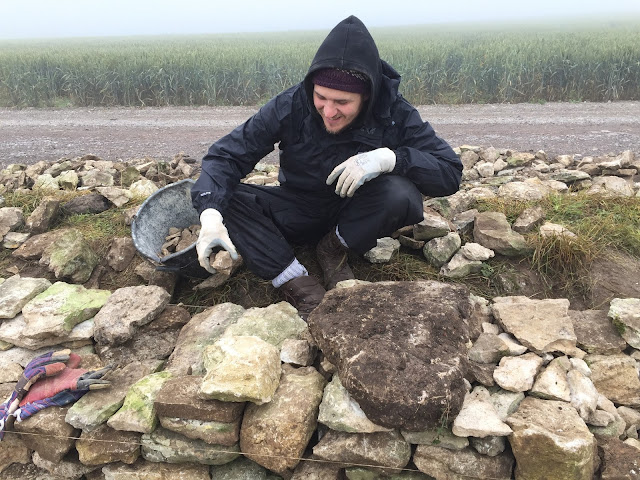 |
| Our walling site is just to the east of Goulds Hill Road and within view of Maiden Castle whose oval earthworks you can see at the top of the above photograph. |
 |
| We look on and wondered where to begin! |
 |
| A flat surface has been cleared and some of the largest rocks that were previously foundations are left in place. |
 |
| The guiding strings are now almost in position. They will be raised up the 'A frames' as the wall rises. A few key foundation stones are already in place. |
 |
| Stone in stock! |
 |
| The entire 12 metre length of foundations stones are almost complete. |
 |
| Looks like someone is starting to build upwards! |
 |
| The end of day one; We admire our work, or is our practical work being critiqued and marked by our tutor? |
 |
| We return to work on Sunday morning! |
 |
| You can just about see the string guide lines on both sides of the wall. They now need to be raised on the 'A' frames so that the wall continues to taper inwards. |
 |
| What a beautiful spot to be working! Looking south here with the English Channel on the horizon. |
 |
| Craig and I shared a two meter section of wall building. This enabled us to ensure that both sides of the wall were geting attended to! |
 |
| Slowly but surely we gained height! Our tutor made regular inspections of each section to check that we were following all the correct procedures! |
 |
| As Sunday morning slipped into Sunday afternoon the wall rose like a phoenix! The supply of available stones became limited and we were now hunting around for each 'right stone'. |
 |
| This shot demonstrates the position of the guiding string that determines the position that we are building towards. |
 |
| Craig concentrating on the far side. |
 |
| Eventually we reach the desired height and are working towards completing a level surface. We have now all been working for about 12 hours. (over 2 days) |
 |
| Finishing touches! |
 |
| Almost complete! |
 |
| We just need to position the topstones or coping stones. |
 |
| Job done! |
 |
| Qualified Dry Stone Wallers! |
 |
| Our view from the new stone bench. |












No comments:
Post a Comment
Note: only a member of this blog may post a comment.